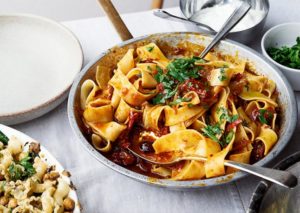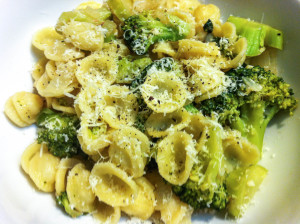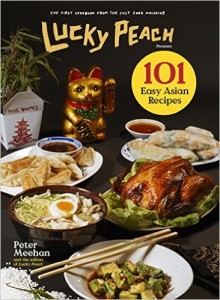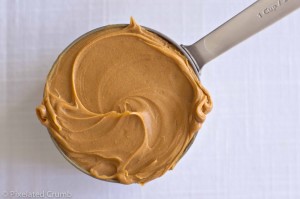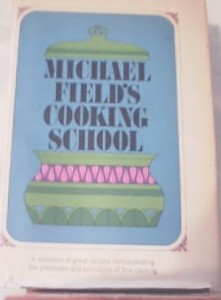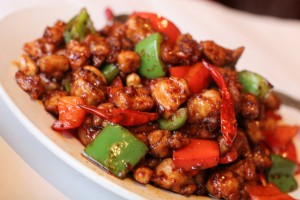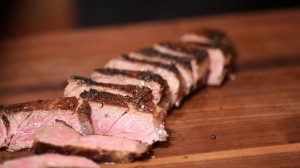Yotam Ottolenghi is HG/BSK’s authority on Israeli/Middle Eastern food. His cookbooks are filled with savory recipes, most of them easy to prepare. A few nights ago, HG browsed YO’s cookbook, “Keep It Simple”, and encountered an unusual dish: “Pappardelle with harissa, black olives and capers”. The sauce is composed of onions, cherry tomatoes and the aforementioned ingredients. The dish is topped with a spoonful of Greek yogurt and chopped parsley. BSK cooked it for dinner. Was it good? A qualified “Yes”. HG still believes that Italian pasta dishes are superior. BSK proved this a few nights later. BSK cooked penne with broccoli sauce. (First encountered this dish at New York’s long closed Delsomma restaurant. It was very tasty, but BSK’s version is even better). BSK topped the pan of pasta with local yellow beans and little potatoes (mineral rich) from Ocean Mist Farm. Grated parmesan. Red pepper flakes. (A splash of olive oil for HG). Italy rules !! Indeed.
Italy Rules
October 12th, 2020 § 0 comments § permalink
Spicy Chinese Eggplant
July 7th, 2020 § 0 comments § permalink
Big eggplant in the fridge. HG peeled the big boy and cut it into chunks. Spicy Chinese eggplant was dinner tonight. Here’s how HG did it. Browned the eggplant in sizzling canola oil. Removed the eggplant chunks when they browned and slightly softened. More oil in the pan. Added two thinly sliced onions. When they softened added chopped garlic (much) and ginger (much). When they cooked slightly, it was time to add soy sauce, oyster sauce, some water, dash of maple syrup (classic recipe calls for sugar but HG prefers maple syrup). Lusty spoonfuls of sambal oelek (HG likes it a bit mouth burning). Put the eggplant back in the pan to simmer and absorb all the flavors. When all was soft and lush, HG topped it with a film of sesame oil and grinds of black pepper. This was served over sushi rice (rinsed thoroughly by BSK before cooking). Fabulous eating. There was leftover rice. Congee in the future?
HG Becoming a Vegetarian?
May 14th, 2016 § 0 comments § permalink
The answer to that question is: “NO!!”. HG enjoys occasional pork chops, steaks, chicken, Mexican menudo and other carnivorous goodies. BTW, can’t wait to taste the Japanese fried chicken that is getting raves at daughter-in-law Exquisite Maiko’s Oni Sauce stand at the famed Brooklyn Smorgasburg. But, for the most part HG and BSK have a diet that emphasizes vegetables, fish, pasta and fruit (There are always apples in the refrigerator and oranges, tangerines and avocados in one of BSK’s big pottery bowls on the kitchen granite island. When summering on Prince Edward Island, HG/BSK eat many pounds of seasonal PEI blueberries and strawberries). It must work because HG is reasonably spry as HG’s 87th birthday looms. BSK will reach an advanced age next month but looks decades younger and is energetic, athletic, creative and joyous. Genes, diet and exercise contribute to BSK’s senior beauty. And, best of all (in the eyes and tummy of greedy HG), BSK’s dinners (after just about 53 years of marriage) keep getting better (and healthier). A few nights ago, BSK prepared Orecciette with Broccoli, a dish from the Italian province of Puglia where it is a regional specialty. Orecciette means “little ears” and these little pasta shapes enclose the broccoli sauce effectively. Permit me to turn this post over to BSK and allow BSK to share the recipe with you lucky readers:
Put chunked stems, 2 cloves of garlic , a large shallot (or spring onion) and a handful of Italian parsley into food processor with a little good quality olive oil.
Saute 3 or 4 anchovy fillets (diced) slowly then add more olive oil and the mixture from the food processor and cook slowly. Add salt, pepper and red pepper to taste.
When the pasta water boils add the broccoli heads and cook briefly (they should still be bright green and have a little crunch). Add them to the anchovy/stem/garlic mix and toss. Keep cooking on low heat.
Cook pasta till it’s not quite done — add it to the mix, turn up the heat and toss vigorously – add a couple of ladlefuls of the pasta water – keep tossing — till it turns creamy. Taste the pasta if it’s still not done – add a little more water and keep tossing.
Serve with good grated cheese (and – if you like top with some chopped fresh tomatoes and some cubed mozerella).
Lucky Peach
November 9th, 2015 § 2 comments § permalink
Lucky Peach describes itself as a “cult food magazine” born out of Chef David Chang’s Momofuku empire. The magazine has published its first cookbook: Lucky Peach presents 101 Easy Asian Recipes. The book is a winner. Don’t miss it. Peter Meehan is the writer. He is one of HG’s favorites, a very down to earth guy with a delightful wit. Loves food (and drink). With HG daughter Victoria and Victoria’s husband/chef Marc Meyer, Meehan authored Brunch: 100 Recipes From Five Points Restaurant, published by Rizzoli. In the Lucky Peach book, the recipes he presents, created by the Lucky Peach editors, reflect the realities of present day life: “We chose favorite dishes and recipes that were naturally simple. We tried to put together a folio of kitchen ideas you can turn to for easy eating on a real-life schedule and budget.” There are cold dish appetizers — “Chineasy Cucumber Salad” and “Silken Tofu Snack” are two. Great group of Asian pancakes including “Apam Balik”, a semi-sweet treat that utilizes brown sugar, corn and chopped peanuts. Lots of soups including “Slow Cooker Pho.” HG’s faves are the vegetable dishes featuring asparagus, string beans, celery, bok choy, eggplant, etc. HG/BSK will be doing lots of all vegetable dinners (plus a pot of rice) using these recipes. And, when feeling carnivorous, HG/BSK will dig into Meehan’s “Cumin Lamb.” Chinese egg noodles and a bottle of California Cabernet will accompany.
Quick And Healthy Lunch
September 17th, 2015 § 2 comments § permalink
Rice vermicelli, the Asian staple, provides the basis for HG’s favorite fast lunch. Very good cold or hot. Makes a great salad. Cook vermicelli in boiling water. (Haiku is a good brand and each package contains a number of individual portions). The noodles cook fast. Drain under cold water. Mix with thin slices of radish, turnip, scallions, sweet onions and shavings of carrot. Dress with soy, ponzu, sesame oil, Vietnamese fish sauce, Sriracha (try various combinations). It’s nice topped with some sliced left over chicken. If you like it hot, stir fry the noodles with red peppers, bean sprouts, bamboo shoots, etc. HG also likes the noodles in a bowl of hot chicken broth. HG adds Tofu, sliced scallions (or watercress), thin strips of ham. Rice vermicelli is a healthier fast cooking option than packaged Ramen. Instant Ramen is consumed in great quantities in college dorms. Unfortunately, the food contains whopping amounts of sodium. Not good for you. Elevates blood pressure.
Peanut Butter: Not Just For Sandwiches
January 12th, 2015 § 0 comments § permalink
Most people think that peanut butter’s only function is as a companion to jelly in a kiddy sandwich. They are wrong. Peanut butter is one of the great cooking ingredients. It is used in many flavorful African soups and stews (Jambo Cafe , Santa Fe’s very good Afro-Caribbean restaurant, serves a coconut, peanut, chicken stew that is an HG favorite). It is the essential ingredient in many Indonesian and Malaysian dips and salads, often accompanying Satays (skewers of seasoned and grilled meat or chicken). When HG is confronted with left over roast chicken, as HG was last night, HG shreds the meat for a peanut buttery take on the Szechuan favorite, Dan Dan Noodles. HG learned to make it when HG/BSK (then West Side of New York residents) attended the cooking class of Karen Lee. To Karen’s delightful peanut sauce recipe HG added some finely chopped Szechuan preserved vegetables. Laid the shredded chicken on top of a platter of room temperature Chinese rice noodles. Mixed it all with the peanut butter sauce. Topped with sliced scallion and watercress leaves. Sriracha on table for added heat. Gorgeous Granddaughter Sofia (very hungry) returned to New Mexico from Christmas in Rhode Island. Joined HG/BSK in devouring the chicken and noodle dish. Not a smidgen left. Tonight, BSK will season and grill some thin pork cutlets. Serve them with some left over peanut butter sauce (for dipping) and a crisp green salad. Peanut butter rules.
Roth Nobel Snub Fury
October 9th, 2014 § 4 comments § permalink
The morning started with HG in a fury. Once more the Nobel Prize committee rejected Philip Roth, HG’s favorite author. Sheer injustice. There is no living author who has produced a body of work to match Roth’s. Yet year after year the Nobel officials reject Roth for the literature prize. SJ has suggested that there is the whiff of antisemitism in the rejection, a sense that enough Jewish authors have won. Maybe? In HG’s youth, HG confronted injustice with direct action on the picket line and in physical confrontation. Now, as a member of the “golden years” population, HG seeks solace in food, wine, strong spirits, New Mexico sun and vistas. And, of course, HG’s good fortune in having BSK, a loving family and a recent addition– Toby, The Wonder Dog. Tonight, HG will hope for better literary judgement in the future and soothe HG’s abraded feelings with Craig Claiborne’s Mississippi smothered chicken. The late Claiborne was a pioneering restaurant critic with the New York Times and author of some very good cookbooks. Claiborne’s chicken recipe calls for a three-pound chicken to be spatchcocked (backbone removed). The flattened chicken is placed skin side down in cast iron pan with sizzling butter. Weighted down with a plate and a five pound object (brick, tomato cans, etc.) so the skin is in direct contact with the pan. Chicken is removed and a roux is made with flour, pan juices and fat, chicken broth. Chicken is put back in the roux and cooked some more until tender. (Check here for a precise recipe). HG does not favor roux. Instead, HG will use white wine, mustard, pan juices, a squeeze of lemon, a few capers and 1/2 teaspoon of corn starch (as a modest thickener). Reduce it all. Enjoy it with BSK’s smashed potatoes, sugar snap peas, ripe heirloom tomato salad, A robust red wine. Fury will subside. Pleasure will rule.
Michael Field: Forgotten Recipe Master
May 27th, 2014 § 1 comment § permalink
A good cookbook usually has many pages stained by spices and sauces. That’s because it is a book that is used, not a coffee table ornament. Michael Field’s Cooking School (published in 1965) was one of the first cookbooks acquired by HG/BSK and the duo has consulted it numerous times for better than 40 years. Michael Field’s recipes are foolproof. In the introduction to the book, Field makes it clear: “I cannot emphasize enough the need to follow these recipes precisely, especially the first few times you make them. Departures are all good and well providing you know exactly what it is you are departing from.” Last night, HG/BSK had two Colorado pals for dinner. BSK prepared a Field classic: Broiled Leg Of Lamb With Avgolemono Sauce. The leg is butterflied and marinated before broiling. The sauce is Greek in origin, lemony and invigorating, excellent over the lamb and even better over the steamed asparagus BSK served. The sauce is composed of egg yolks, lemon juice and chicken broth (plus a bit of arrowroot, cayenne and salt). Add more chicken broth and you’ve got a delicious soup (HG often had many bowls at the Pantheon Restaurant on Eighth Avenue in New York). Add rice, poached chicken and chopped parsley and you’ve a got a sumptuous dinner (precede it with a mezze of feta cheese, Kalamata olives and giant lima beans). Instead of chicken in the soup, try poached cod or other firm fleshed fish. Don’t see Avgolemono on many menus these days. A pity. As for Michael Field, he and his cookbooks seem to be forgotten. That’s a shame.
Wow! Kung Pao!
May 22nd, 2014 § 0 comments § permalink
BSK is a very proficient cook of certain types of Asian food, especially the fine art of stir-frying. The secret, says BSK, is speed and organization. Stir frying is a high heat proposition. Everything must be ready with all elements of a dish ready-to-go in separate bowls to be added to the wok in proper order. As sous-chef, HG does much preparation. Kung Pao chicken is a wonderfully spicy, flavorful dish. When served in a restaurant, Kung Pao is usually a mockery of Chinese cooking: Too sweet, sauce thick and gloppy and sometimes dyed a ferocious shade of red. BSK’s version avoids each and every one of those pitfalls — she uses only very modest amounts of sugar and corn starch and of course, no food dye. First, BSK cuts Chicken breasts into small pieces and marinates them in soy sauce, sugar, rice wine, corn starch and Szechuan peppercorns. Then BSK slices scallions, garlic, ginger and dried red chiles. When all the elements are in place, BSK works her magic with the sizzling wok, crowning the dish in its final moments with a sprinkling of roasted peanuts. A BSK masterpiece: food with crunch, spice, heat and flavor.
HG Told You So!
May 17th, 2014 § 0 comments § permalink
Some time ago HG advised HG’s faithful followers that the only way to cook steak is the smoky, satisfying cast-iron-on-a-stovetop method. This involves heating a cast iron pan to the ultimate, sprinkling it with kosher salt and adding a well dried New York strip (or rib) steak and giving it a robust, crusty sear on both sides before turning down the heat. Well, in the New York Times Dining section today, Julia Moskin reiterates this advice (and illustrates it with a nice video). Moskin advises that after it is seared, the steak should be turned every 30 seconds. Crushed pepper should be added, she says, just before the steak nears readiness as pepper burns easily. Some HG counsel: If you like rare steak (anything else is a waste of good meat), take it off the heat while it is still very red in the interior. Let it rest for 5-10 minutes before slicing to let the meat’s juices re-circulate. During the “resting period,” it will continue cooking to the right saignant (as the French put it) point. The eccentric French (lovers of Jerry Lewis) like their steak “bleu”, not “saignant.” “Bleu” is raw beef with a modest sear. Enhance your steak with a pat of butter or top it the Tuscan way with a splash of fruity olive oil and crushed garlic. Pass that bottle of Cabernet Sauvignon down here, please.
